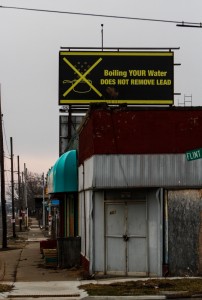The Flint Water Crisis is just that – a crisis – because the authorities tasked with disaster mitigation worked against victims. The Michigan governor’s office, city officials, the Michigan Department of Environmental Quality (DEQ), and the U.S. Environmental Protection Agency (EPA) had a responsibility to test the validity of claims. Instead they denied the change in water quality and the existence of environmental hazards (lead). These agencies used science to shut down concerned community members. It was only when community members themselves began to seek out and provide their own scientific data that they could enter into conversation.
Much of the crisis can be seen as a vastly unequal dialogue between Flint residents and DEQ and city officials. The month after citizens began filling their cups and baths with Flint River water, they began complaining. Some, like Bethany Hazard switched to bottled water over concern for the “murky or foamy” liquid coming out of her tap.[1] The new water, “70 percent harder than lake water,” looked, felt and smelled nothing like that from Detroit.[2] Nevertheless, DEQ officials concluded “turbidity, residual chlorine and bacteria levels” in addition to “nitrates, metals, residual disinfectant, and arsenic” met state standards.[3] Rather than consider the implications of the disparity in water quality, officials suggested that residents adjust their expectations. Emergency Manager Darnell Earley told residents, “We are not going to see the (same type of water),” as if to say, You should expect your water to be nasty.[4] He made no mention of what different quality should mean for water costs – which citizens were already struggling to pay. Earley emphasized that DEQ water safety standards – not community complaints – would guide city policy.[5]
Months later, test results on the new water showed positive for E. coli, or fecal coliform bacteria. City officials issued a boil advisory, but stated that the measure was only a “precaution” and the product of an “abnormal test.”[6] Another round of tests came back positive for total coliform – an indication of a contaminated water system (not just the water itself).[7] The implications of this finding were downplayed. The city issued more boil advisories. To address the E. coli issue, water treatment officials added more chlorine. In this decision Flint had its worst violation yet, exceeding maximum contamination levels of trihalomethanes, or TTHM – “disinfection byproducts” – outlined by the Safe Drinking Water Act.[8] The city identified no necessary action for residents. The answers to FAQs from concerned citizens on Flint’s website read, “Do I need to boil my water? No. This is not an emergency. If this were an emergency you would have been notified within 24 hours. Is water from the Flint River safe to drink? Yes. The water meets the EPA regulatory standards that say it is safe to drink.”[9]
Worse yet, it seems the city held onto TTHM findings for eight months before bringing it to public attention.[10] Meanwhile, Flint-based General Motors made a deal with Flint Township (adjacent to Flint) – which was still receiving water from Detroit – to change its water source back after it found that chloride levels in Flint River water corroded car parts.[11] In the name of fiscal responsibility, EM Darnell Earley turned down the opportunity to broker a deal for Flint, despite residents’ demands to do so. Statements made by citizens such as, “These people [emergency managers] are supposed to make sure we’re safe,” speak to shared concerns over Emergency Managers–fiscal “experts” –having been tasked with public health.[12] Months later, a consultant from environmental and sustainability firm Veolia North America paid by state officials assured residents that the water was in compliance with TTHM levels.[13] In keeping with a trend of image preservation, as opposed to disaster mitigation, Flint officials made only an effort to prove that water was up-to-standard in regards to a specific violation (TTHM). They did not think to run more comprehensive tests for hazards such as lead and copper, despite Veolia stating that the issue in Flint appeared to be “about the (transmission pipes).”[14] The reality of Flint’s water hazards was far worse than E. coli, or even TTHM and would only be unearthed through the action of citizens and independent researchers.
The first sign of potential lead contamination in Flint water came from a state health worker. Epidemiologist Cristin Larder saw elevated blood lead levels in Flint children during the period of July, August, and September of 2014 and passed this information on to superiors for “further investigation.”[15] They did nothing with the data. Content with the post-September drop in lead levels, they defined the spike as a “seasonal anomaly.”[16] Flint resident LeeAnne Walters, after watching her children grow sick and break out in rashes, sent water samples to Marc Edwards, a professor of environmental engineering at Virginia Tech. The samples showed lead levels to be 13,000 parts per billion for Walters’ water with an average of 2,000 parts per billion.[17] According to an article in The Atlantic, “The EPA recommends keeping lead content below 15 parts per billion.”[18] Edwards said it was “the worst I’d ever seen.”[19] Edwards sent the data off to the EPA and to Flint health officials. They did nothing; ditto for Flint.
This was not the first case of the EPA – the agency that is supposed to act when the city and state DEQ do not – failing Flint. An ACLU leak revealed that the EPA’s water expert, Miguel Del Toral, had warned the organization about lead leaching from pipes in Flint.[20] Among the many poignant points in his memo is, “At a MINIMUM, the City should be warning residents about the high lead…The only people that question the science are the ones that have a vested interest in not finding lead.”[21] Higher-ups dismissed his memo on the grounds of questionable sampling, and Del Toral’s findings were kept within the EPA for four months before being released – and revised.[22] The EPA also failed to implement the Lead-Copper Rule (intended to prevent lead and copper contamination of water), by allowing the DEQ to put off instituting corrosion controls and, in turn, expose the city’s residents that much earlier to dangerous neurotoxins.[23] It seems the EPA had a “vested interest in not finding lead.”
In Flint, Marc Edwards saw an eerie resemblance to the Center for Disease Control and Prevention’s (CDC’s) falsification of findings pertaining to lead poisoning in Washington DC – a 2004 scandal.[24] His six-year fight and victory against the CDC made him primed to take on the Flint Water Crisis. Self-funded and with the help of Virginia Tech students, Edwards has conducted two large-scale samples of lead levels in Flint. His work provides residents what they have always wanted – science that is used to educate and engage, not to dismiss those affected. Edwards has used Freedom of Information Act Requests to get access to “documents and emails of state and city officials” and to make visible what had previously been a hidden scandal.[25] With a history of success against seemingly irrefutable agencies, Edwards validated the concerns of Flint’s residents such that officials could no longer ignore them. Other independent actors followed in Edwards’ footsteps. Flint pediatrician Mona Hanna-Atisha examined the effects of then apparent water lead levels in children. She found a 3.5% increase in blood lead levels and a 6.6% increase in communities with the “highest water lead levels.”[26] It took weeks of denial for city officials to finally acknowledge the validity of her data. The mental and physical implications for Flint’s estimated 10,000 under-6 children was not lost on the public and the outrage that resulted has prompted the city to begin tracking the health of those affected.[27]
Reflecting on what is now a national crisis complicates the notion of scientific expertise. The Department of Environmental Quality and EPA are the sources we’ve been led to believe are the agencies with the knowledge to respond in the case of an environmental disaster. However those authorities’ will for knowledge in the case of Flint was clouded by the expectation that the Flint River was to be Flint’s water source. There could not be contaminants in the water because that would mean the failure of Flint officials’ water project. Whatever contaminants were proven to be irrefutably present were addressed singularly, without consideration for other possible hazards. The findings these agencies produced were not knowledge, for they had no scientific clout. It they did, they would have been reconciled with the local knowledge that Flint River water was affecting residents. It would take a combination of data from trusted researchers (e.g. Edwards and Hanna-Atisha) and proven malfeasance by agencies and officials involved to expose Flint for the fiasco it is.
[1] Ron Fonger, “State says Flint River water meets all standards but more than twice the hardness of lake water,” The Flint Journal, May 23, 2014, accessed April 14, 2016, http://www.mlive.com/news/flint/index.ssf/2014/05/state_says_flint_river_water_m.html.
[2] Ron Fonger, “City adding more lime to Flint River water as resident complaints pour in,” The Flint Journal, June 12, 2014, accessed April 14, 2016, http://www.mlive.com/news/flint/index.ssf/2014/06/treated_flint_river_water_meet.html
[3] Fonger, “State says Flint River water meets all standards”
[4] Fonger, “City adding more lime to Flint River”
[5] Fonger, “City adding more lime to Flint River”
[6] Fonger, “Flint officials say ‘abnormal’ test to blame in E. coli scare, water boil advisory remains,” The Flint Journal, August 18, 2014, accessed April 14, 2016, http://www.mlive.com/news/flint/index.ssf/2014/08/flint_officials_say_abnormal_t.html#incart_river.
[7] Fonger, “Tests positive for total coliform again in water-boil area on Flint’s west side,” The Flint Journal, August 19, 2014, accessed April 14, 2016, http://www.mlive.com/news/flint/index.ssf/2014/08/water_boil_area_in_flint_gets.html.
[8] Fonger, “City warns of potential health risks after Flint water tests revealed too much disinfection byproduct,” The Flint Journal, August 19, 2014, accessed April 14, 2016, http://www.mlive.com/news/flint/index.ssf/2015/01/flint_water_has_high_disinfect.html.
[9] Fonger, “City of Flint posts frequently asked questions & answers about drinking water violation,” The Flint Journal, January 6, 2015, accessed April 14, 2016, http://www.mlive.com/news/flint/index.ssf/2015/01/city_of_flint_posts_its_answer.html.
[10] Jim Lynch, “EPA stayed silent on Flint’s tainted water,” The Detroit Free Press, January 12, 2016, accessed April 14, 2016, http://www.detroitnews.com/story/news/politics/2016/01/12/epa-stayed-silent-flints-tainted-water/78719620/.
[11] Ron Fonger, “General Motors shutting off Flint River water at engine plant over corrosion worries,” The Flint Journal, October 13, 2014, accessed April 14, 2016, http://www.mlive.com/news/flint/index.ssf/2014/10/general_motors_wont_use_flint.html.
[12] Ron Fonger, “Flint residents protest drinking water problems outside City Hall,” The Flint Journal, October 13, 2014, accessed April 14, 2016, http://www.mlive.com/news/flint/index.ssf/2015/01/clean_water_is_a_right_and_a_p.html.
[13] Ron Fonger, “Despite quality problems, ‘Your water is safe,’ says Flint consultant,” The Flint Journal, October 13, 2014, accessed April 14, 2016, http://www.mlive.com/news/flint/index.ssf/2015/02/flint_consultant_tells_city_de.html.
[14] Fonger, “Despite quality problems”
[15] Stephanie Gosk and Tracy Connor, “Email Was ‘Missed Opportunity’ to Save Flint’s Kids From Lead,” NBC News, January 13, 2016, accessed April 14, 2016.
[16] Gosk and Connor, “Email Was ‘Missed Opportunity’”
[17] Alana Semuels, “Aging Pipes Are Poisoning America’s Tap Water,” The Atlantic, July 29, 2015, accessed April 14, 2016, http://www.theatlantic.com/business/archive/2015/07/dont-drink-the-water/399803/.
[18] Semuels, “Aging Pipes”
[19] Semuels, “Aging Pipes”
[20] Rappleye, Seville, and Connor, “Bad Decisions, Broken Promises”
[21] Lynch, “Whistle-blower Del Toral grew tired of EPA ‘cesspool,’” March 29, 2016, http://www.detroitnews.com/story/news/michigan/flint-water-crisis/2016/03/28/whistle-blower-del-toral-grew-tired-epa-cesspool/82365470/.
[22] Lynch, “EPA stayed silent on Flint’s tainted water,” The Detroit News, January 12, 2015, accessed April 14, 2016, http://www.detroitnews.com/story/news/politics/2016/01/12/epa-stayed-silent-flints-tainted-water/78719620/.
[23] Lynch, “EPA Stayed Silent”
[24] Colby Itkowitz, “The heroic professor who helped uncover the Flint lead water crisis has been asked to fix it,” The Washington Post, January 27, 2016, accessed April 14, 2016, https://www.washingtonpost.com/news/inspired-life/wp/2016/01/26/meet-the-heroic-professor-who-helped-uncover-the-flint-lead-water-crisis/.
[25] Itkowitz, “The heroic professor”
[26] Mona Hanna-Atisha, “Elevated Blood Lead Levels in Children Associated With the Flint Drinking Water Crisis: A Spatial Analysis of Risk and Public Health Response,” American Journal of Public Health, February 2016, 106(2): 283-90.
[27] Gosk and Connor, “Email Was ‘Missed Opportunity’”


